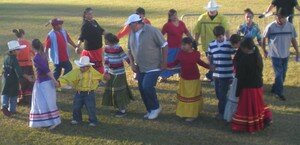What is a Stomp Dance
The Coushatta, Alabama, Seminole, Creek, Chickasaw, and Choctaw tribes are all related, Muskogean tribes. We share traditions, ceremonies, and even language through this relationship. One of those traditions is a dance commonly known to these tribes as the Stomp Dance.
What is a Stomp Dance?
The Stomp Dance is a form of dance to celebrate our culture. Dancers dance in a counter-clockwise circle, woman following man following woman, and so on. Women wear long skirts and turtle shell “shakers”, one of the main components in making the music. Men “call” and are the highlight of the song by setting the pace of the dancers. This particular dance is common to Indians in the Southeast part of the United States. The dance is celebrated socially and religiously. Social stomp dances are held throughout the year and can be held indoors or outdoors, with or without a fire. Religious stomp dances are held during the summer at the height of the new crop season at particular stomp dance grounds during the Green Corn Ceremony.
What does the Green Corn Ceremony have to do with the Stomp Dance?
The Green Corn Ceremony is a festive holiday our Koasati ancestors once participated in to give thanks to Abba Chokoli, our Creator for providing us with food, life, and faith. The ceremonial fire provided for the Green Corn Ceremony is never allowed to burn out. It is made to represent the ongoing faith and belief for Abba Chokoli. As we dance the Stomp Dance during the night our prayers are symbolically sent to Him through the smoke flowing high above the fire to the Heavens. As we dance we pray, give thanks, and ask for forgiveness of our sins through song and dance.
How do you ‘lose’ a tradition?
It is very common for cultures to lose traditions over time for different reasons. For our Coushatta people, the struggle to maintain the lands our ancestors thrived on forced us to move from our original lands of Tennessee to Texas and then finally to Louisiana. Influence from non-Indian cultures and religion made a big impact toward losing our Koasati ways. Presently, very few of our people know the original dances, songs, and ways of our ancestors.
How do we know the Stomp Dance is a part of our Koasati tradition?
Historical accounts of the Koasati people participating in the Stomp Dance and Green Corn Ceremonies do exist. One of the first anthropologists to research our tribe was named John Swanton. His research revealed many facts about the Koasati tribe, including details of our migration and how our people used to live among the Creek villages. There are many resources that detail our people’s history in old documents, researchers’ notes, and many books.
